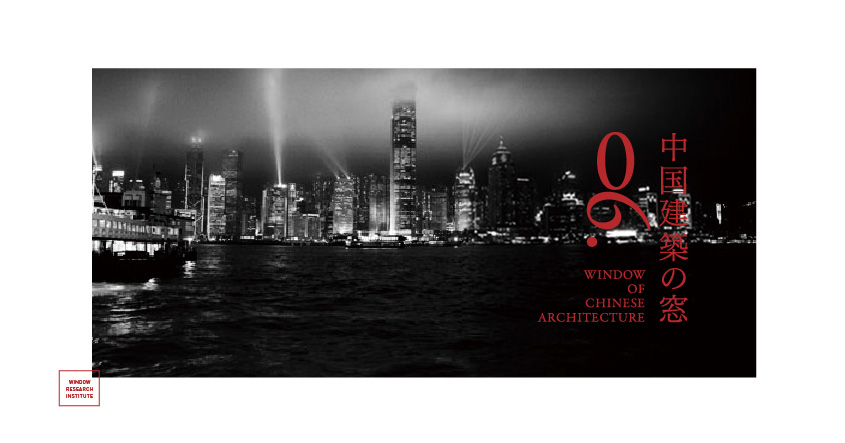
Series Windows in Chinese Architecture
Part 6: Proverbs Left to us by Laozi
05 Dec 2018
The aperture in Japanese architecture is the “ma,” or “space between objects.” The aperture in western architecture is the “hole.” What is it in Chinese architecture, then? This is a study on the as of yet unknown culture of windows in Chinese architecture from classical times to the present day.
Recently, Taro Igarashi Laboratory published a book called “Aphorisms on Windows and Architecture,” through Film Art Inc. The Igarashi Laboratory has worked on many research projects with the Window Research Institute, and this book is an edited version of their work from 2012. I too contributed by presenting and analyzing proverbs written by an architectural historian named Líu Dūnzhēn as examples of “window proverbs” from China. At the end of last year, “Towards Windows: Windows into Society and Culture” (published by The Kensetsutsushin Shimbun Corporation), a book that was also based on the results of “windowology” research by Igarashi’s Lab and compiled the content of a series that they had posted on Digital Kensetsu News’ website, was published. You will probably enjoy this article more if you read those two books as well.
When I contributed the Chinese window proverbs for “The remarks of a window and architecture,” I read many books and found several interesting proverbs other than those written by Líu Dūnzhēn. Of particular interest among them was one written by Laozi. It need not be said, but Laozi is an ancient Chinese philosopher and not an architect, so I refrained from suggesting we include his proverb in the study, but I believe his window proverb is extremely thought-provoking when investigating windows in Chinese architecture. As such, I would like to introduce and analyze it here.
Laozi’s window proverb goes something like this:
鑿戶墉以為室,当其無,有室之用。故有之以為利。無之以為用。
This comes from the eleventh chapter of Laozi’s “Tao Te Ching”. If I were to translate it into English, it would mean something like, “A home is born when a door or a window is dug out. Because there is open space in a home, one can use the space as a home. The existence of the object adheres to a person’s convenience, and the absence of something is what is useful.”
“A home or a building is first born with the act of digging a window or door into a wall.” If one were to interpret Laozi’s proverb simply, one might interpret it like that. In this case, the meaning of the idea of a home (or building) is not in the object that exists around the open space, but in the “nothingness” or emptiness that is surrounded by that object. It is well known that Laozi’s thought process, in which importance is placed on the empty space that is created by an object rather than the object itself, had a strong influence on modern American architect Frank Lloyd Wright. Indeed, depending on how one reads it, one can take Laozi’s words to mean that the primary role of architecture is in empty space and the functionality of that space as well as the behavior of those who occupy it. This way of thinking resembles the functionalism that modernist architects advocate for and Wright’s work attempted to capture.
Precisely what kind of structure did Laozi have in mind when he wrote this proverb? Though there is no way to know for certain, based on the words “a home is born when a door or window is dug out,” one might imagine a primitive cave dwelling. The remains of some cave dwellings that were dug into the face of a cliff in Beijing called the Guyaju Caves have survived until now, sure, but there are still cave dwellings being used extensively to this day in the Loess region in western China. These residences are called Yaodongs. Since rainfall is uncommon, villagers dig out the hard and sticky loess ground or the faces of cliffs to build their homes. Though I call them cave dwellings, nowadays many different kinds of decorations fill the rooms and they have matured so that wooden sash doors and glass windows separate the inside from the out. Anyway, one can say that in the case of these cave dwellings, the act of digging out a door or window is directly linked to the act of “making a building.” Can one not say that a home of “nothing” is being made from the “something” that is the loess soil in this example?
To expand further on my interpretation of Laozi’s proverb, one can say that it points to a universal tendency regarding the usage of space that appears in traditional Chinese residences.
China is a massive country geographically. Though I use the words “traditional residential architecture,” the designs and structures of these buildings are hugely variant depending on the region and ethnic origins of the people building them. That said, one can also point to a common characteristic among them: the fact that they all create an extremely closed off space from the outside world. Residences called tulou, which are common in Fujian province, are the model example of this. The tulou, with courtyards at their center within which lies an ancestral altar, are round houses that wrap around each other in many layers of concentric circles. They block out the outside world with a solid 2 or 3 meter wall that resembles a castle wall, and only have small crenel-like windows in their top floors.
Tulous developed with such robust walls in order to fight off bandits and other foreign threats, but homes in inner cities have the same formation. Siheyuans, the representative inner city residences of Beijing, have large courtyards in their centers and extremely large stretches of the building directly face the natural environment. It is a liberating structure for a living space, yet at the same time the overall design does indeed close out the outside world. They are surrounded on all sides by a sturdy brick wall, and the only entrance is the “Front gate” in the southern wall. Also, since the belief that a building should face south was strong in northern China, siheyuans connect with roads on their southern facing side. Along the southern wall is where the guest rooms, called the dào zuò are typically arranged, but the south facing windows of these dào zuò are equipped only with thin, small windows. If one wanted to bring light into the room one would make these windows larger, but enclosing and completing the complex was prioritized over bringing in light.
Looking at traditional Chinese residences like this, one can say that the notion of first establishing a secure space or territory for oneself, then controlling the relationship between that space and the outside world with windows and gates, was firmly set in China. The residences discussed here are of styles that can be considered realizations of Laozi’s proverb, “homes are born by digging out a window or a door.” Laozi’s window proverb encompasses precisely the spatial characteristics of Chinese buildings and their universal relationship with windows.
Another thing that is interesting about Laozi’s proverb, “a home is born when a door or a window is dug out,” is the fact that it seems to have a close affinity with the meaning of Hiroshi Hara’s thesis, which says “one starts with a closed space in the beginning.”
According to Mr. Hara, in the beginning there is a closed space, and by digging a hole into that space a building is born. As has been made clear in the Window Research Institute’s interview, windows were a topic of great interest in Mr. Hara’s lengthy work in architectural design, which started with “Yukotai (porous body)Theory.” This is because Mr. Hara related architecture itself to windows at a base level. In the beginning is a closed space, and by digging a window or door into that space, light, air and people can pass into and out of it, giving birth to a building. To Mr. Hara, who held this to be true, the act of installing a window was equivalent to the birth of a building.
We have two individuals, Laozi who said “a home is born when you dig out a door or window,” and Mr. Hara, who said “one begins with a closed space,” and architecture is when you open a hole into that space. These two individuals who are separated by more than 2,000 years came upon the same idea by following the role of windows to their most basic level.
Kouji Ichikawa
Born in Tokyo in 1985. Currently he’s in a doctorate program in Tohoku University’s Engineering Research Department. His research topic is the theory and history of pre-modern and modern Chinese architecture. He is the editor in chief of the amateur architecture magazine “Nemoha.”











